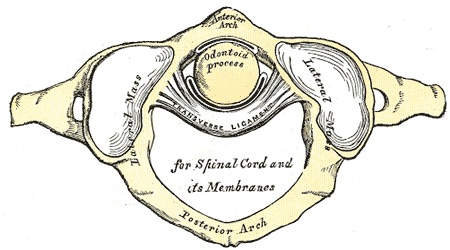C1 cervical vertebra
The first cervical vertebra, the atlas, arguably does not belong to the cervical spine. It has more in common with the occiput than with the rest of the neck. It is designed to cradle the occiput and transmit forces from the head to the cervical spine.
Quintessential features are its 2 lateral masses; each is a stout pillar of bone whose long axis is aligned vertically below the corresponding occipital condyle.
The lateral masses are united by anterior and posterior arches of bone that function as outriggers to maintain the relative positions of the lateral masses and allow them to act in parallel and give the atlas its characteristic ring shape.
The C1 is of the two upper cervical vertebra, also known as atlas, which is the topmost vertebra of the spinal column. It is the vertebra that is in contact with the occipital bone.
The atlas has no vertebral body; however, it is composed of a thick anterior arch with 2 prominent lateral masses and a thin posterior arch.
This first cervical bone is named from the mythical Greek god who carried the world on his shoulders, as its function is to support the globe of the head. Together with the second vertebra, the axis, it is responsible for the wide range of motion of the head. The atlas does not look like a typical vertebra, with its ring-like structure and the absence of a body, which is actually fused to the axis. It also contains an anterior arch and tubercle, posterior arch and tubercle, vertebral notches, facets, and transverse processes.
C1 cervical vertebra Ossification Patterns
The three primary ossification centers that appear around the seventh week of fetal development: one for the anterior arch and lateral masses, and one for each posterior arch. These centers gradually fuse together during childhood, with fusion typically completed by the age of 7-8 years.
C1 cervical vertebra transverse process
C1 posterior arch
Atlas fracture
see Atlas fracture
